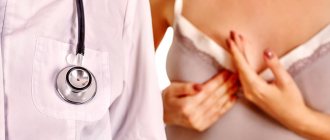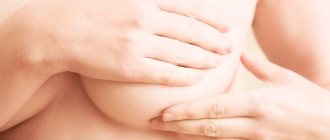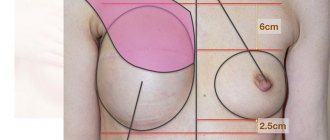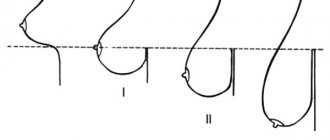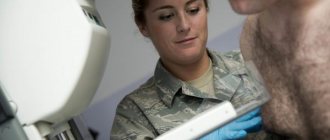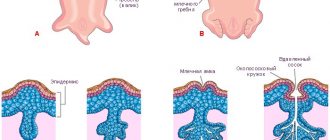Large, high, elastic breasts are an undeniable feminine advantage that always attracts the interested glances of the opposite sex. It is these forms that many men consider the main female sexuality.
Social surveys constantly conducted on this topic indicate that almost 90 percent of the women surveyed are dissatisfied with the size and shape of the mammary glands. This problem is especially acute among young teenage girls.
They are very worried if their breasts do not grow - against this background, quite serious psychological complexes can develop. Problems of puberty in adolescence also often worry parents. To understand whether pathological disorders occur, you should understand the stages of female breast growth, starting from childhood.
What factors can affect breast size?
The first signs of puberty in girls begin to appear at approximately 9-10 years of age. It is at this time that the development of the mammary glands begins. However, it should be understood that this complex natural process is extremely individual. There are a huge number of different factors influencing the size and shape of the bust:
- Heredity. If all the women in the family (sister, grandmother, mother) have small breasts, then the girl’s mammary glands will not grow beyond a certain size, no matter what she does.
- Build. One of the main components of the mammary gland is adipose tissue. Therefore, relatively often the breasts of thin teenage girls grow weakly due to a lack of fatty tissue in the body. In addition, in adult women, breasts may shrink and lose shape when following various weight loss diets.
- The content of estrogen in the body (a hormone that stimulates the development of the mammary glands, uterus, fallopian tubes, vagina). If this hormone is not enough, the girl’s breasts will grow slowly and may not reach the maximum possible size. A low amount of estrogen often indicates a dysfunction of the thyroid gland. The fact is that the normal functioning of the thyroid gland ensures the normal functioning of the sex glands, which produce estrogen in the required quantities.
- Lifestyle. Participating in certain sports can severely limit breast growth. For example, if a young girl is seriously involved in swimming, overdeveloped muscles of the shoulder and pectoral girdle do not allow the mammary glands to develop properly - this can result in flat breasts. Conversely, volleyball contributes to the formation of a toned, well-developed bust. In addition, playing professional sports often carries an increased risk of breast injury, which can greatly impact future breast development.
- Proper nutrition. A lack of vitamins and minerals in a teenage girl's body can lead to delayed puberty. In order for the mammary glands to develop correctly, a teenager needs to be provided with a nutritious, balanced diet.
- Normal psychological state. Psychosomatics is a serious matter. Constant stress, frequent worries, long-term depression negatively affect the general condition of the body, which means the growth and development of the mammary glands may be impaired.
- “Bad” ecology - polluted air, water, soil can cause various pathological changes in a teenager’s body, which, in turn, can slow down the growth processes of the mammary glands during puberty.
Question to the expert
Good afternoon. My daughter is 13 years old and I haven’t seen any signs of breast development yet. Recently I began to notice that she was slouching a lot. Tell me if your breasts may not grow due to poor posture.
Good afternoon. Yes, indeed, you have cause for concern. Poor posture is one of the symptoms of scoliosis. This pathology in itself does not affect the growth and development of the mammary gland. However, without appropriate treatment, it can progress, having a negative impact on the functioning of many organs and systems. Contact an orthopedist immediately.
Breast development abnormalities
In medicine, 2 groups of breast malformations have been identified. True defects arise as a result of genetic and chromosomal diseases or appear due to adverse effects in utero on the rudiments of the mammary glands. Group 2 includes acquired defects that arise due to endogenous (hormonal) or exogenous (irradiation, infections, trauma) causes.
With any defect, defects occur on one or both sides. Anatomical classification divides into anomalies:
- forms (aplasia, etc.);
- quantities;
- location (ectopia, asymmetry);
- by the number of glands and nipples.
Monomastia is when, while still in utero, one of the mammary glands has stopped growing (developing). The nipple is also missing. Polymastia is characterized by the presence of additional mammary glands under normally developed breasts or in other places: neck, labia, back. Amastia – two or one gland is completely absent.
Atelia and polythelia are nipple anomalies. In the first case they are absent, in the second there are more than two. At the same time, the mammary gland itself is fully formed.
Macromastia and micromastia – changes in bust volume. With macromastia, the mammary gland is hypertrophied and has a gigantic size in relation to the body and genitals. Doctors diagnose micromastia when the size of the mammary gland is excessively small, which does not correspond to the height, age and body weight of the owner.
Hypoplasia is a small, underdeveloped bust. It can be acquired when the mammary gland shrinks with age, with sudden weight loss, or after lactation a woman notices that her breasts have disappeared.
Breasts do not grow at 10-11 years old - is this normal?
As already noted, the average age for the formation of mammary glands to begin is 10-11 years. But each organism is individual. In some girls, signs of breast growth can be observed starting at age 8, and in others, puberty begins at 12-13 years.
This depends on many factors. For example, it depends on the climatic conditions of their residence - in warm climates, the first signs of puberty in girls appear much earlier than in adolescents living in regions with lower average temperatures. An important role in this case is played by heredity and the general condition of the child’s body.
If at 10-11 years old no changes are noticeable in the mammary glands, there is no need to panic.
It is necessary to provide the girl with adequate nutrition and optimal (but not excessive) physical activity. The psychological state is also important - the teenager should be protected from any stressful situations if possible. All this will help maintain health, and, therefore, sexual development will proceed correctly.
Question answer
It is impossible to give an exact figure.
The development of this paired organ begins around the age of 10, but the final formation is observed until the age of 20. It is worth noting that weight gain or loss affects breast volume. It is a myth. Research was conducted to prove the absurdity of such a theory. During the study, it was proven that eating this vegetable does not affect breast growth. But this does not mean that cabbage does not benefit the body. As for the mammary glands, the vegetable helps protect against the appearance of neoplasms, the development of mastitis, and adds elasticity to the skin.
There is no “magic” food that will affect your bust size. But some products help maintain the elasticity of the skin in this area. These are walnuts, pumpkin, soybeans, flaxseeds, and legumes.
What to do if breasts do not grow at all at 12-13 years old
This is already a cause for concern. If no changes are noticeable at the age of 12-13, you should see a specialist. You need to be examined by a mammologist and a pediatric gynecologist. It is likely that no violations will be identified and will not be found. Delayed puberty often depends on the individual characteristics of the teenage girl’s body. If a pathology affecting puberty is identified, based on the results of the tests obtained, the doctor will prescribe the necessary treatment.
Question to the expert
Hello. My daughter is 13 years old and has not yet seen any visible signs of breast growth. Tell me, if my breasts are not growing, which doctor should we contact?
Good afternoon. Considering your child’s age, there is no particular cause for concern yet, but it won’t hurt to consult a specialist. Contact a pediatric gynecologist and mammologist, and then, if necessary, they will refer you to other specialized specialists.
Diagnostics
If one breast has become noticeably larger than the other, you should make an appointment with a doctor. First, visit a mammologist, who should conduct an initial examination with palpation, and if abnormalities are detected, prescribe additional diagnostic procedures: ultrasound, mammography, in some cases histological examination, MRI or CT (for high risks of cancer).
Based on the results of the examination, the mammologist can recommend an appointment with specialized specialists: gynecologist, oncologist, endocrinologist, geneticist, surgeon.
Why don't breasts grow at 14, 15, 16 years old?
This age period is characterized by the most intensive growth of the mammary gland. It is at the age of 14-16 that for most girls the shape and size of the breasts are finally formed and it becomes clear what kind of bust a woman will have in the future.
If breasts do not grow at this age, this indicates serious problems with the body. What you might suspect:
- Hormonal imbalance is insufficient production of estrogen in the body. The reasons for this may be different - dysfunction of the thyroid gland, adrenal glands. The ovaries may not produce the amount of estrogen necessary for normal puberty as a result of their damage to polycystic disease.
- A serious deficiency of vitamins and microelements, developing as a result of an unbalanced diet.
- Lack of nutrients due to digestive disorders causing poor absorption of nutrients. Unfortunately, many girls at this age already smoke and abuse caffeine-containing drinks. Excessive amounts of coffee and smoking have an extremely negative effect on the functioning of the gastrointestinal tract. The absorption of nutrients can be disrupted due to parasites - worms, in the process of their vital activity, secrete substances that negatively affect digestion and the general condition of the body.
- Lack of adipose tissue due to the thoughtless use of various diets.
In any case, if at the age of 14-16 the breasts do not grow, you should definitely seek advice from specialists. The exact cause can only be determined after a full examination.
Question to the expert
Good afternoon. My name is Anna, I'm 14 years old. All the girls in the class already wear bras, but I have no breasts at all. Tell me why my breasts are not growing.
Hello Anna. Yes, indeed, at your age the mammary glands should already begin to actively develop. There may be many reasons why this does not happen - these are hormonal disorders, vitamin deficiency, various disorders of the stomach and intestines. You need to contact a mammologist and pediatric gynecologist. The doctor will prescribe the necessary tests to determine the exact causes. Depending on the reasons, therapy will be prescribed.
When operations are contraindicated
All operations described above have general contraindications:
- any neoplasms;
- ARVI;
- other severe infections;
- diabetes;
- foci of dermatological diseases, inflammation or ulcers on the chest;
- blood clotting disorders;
- mastopathy;
- pregnancy;
- minor age;
- acute general inflammatory processes;
- tendency to keloid scars;
- severe mental disorders;
- lactation and the six-month period after its complete completion;
- exacerbation of chronic diseases.
How to prepare for mammoplasty
Preparation for surgery requires, first of all, a comprehensive examination, including ultrasound examination of both mammary glands, ECG and fluorography, sometimes CT or MRI, and radiography. Blood tests are taken for coagulation (coagulogram), for syphilis, HIV and hepatitis, for group and Rh factor, for biochemistry, as well as general urine and blood tests. Sometimes consultations with specialized specialists are required: cardiologist, endocrinologist, phlebologist, oncologist, mammologist.
Preparation involves the following rules:
- refusal to take medications that affect blood clotting (two weeks before mammoplasty);
- quitting smoking, alcohol and junk food a week before the surgery date;
- taking a bath/shower the day before plastic surgery;
- stopping the consumption of food and liquids 9-12 hours before the start of the intervention.



